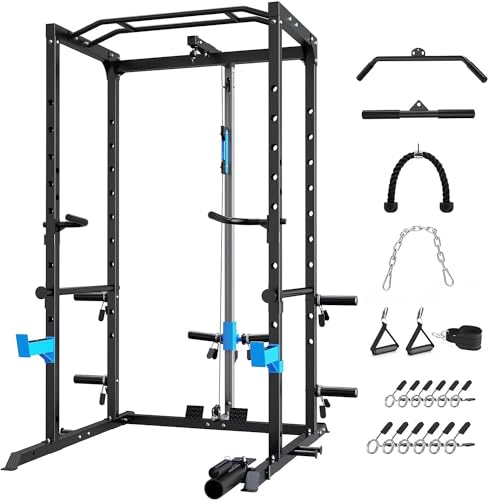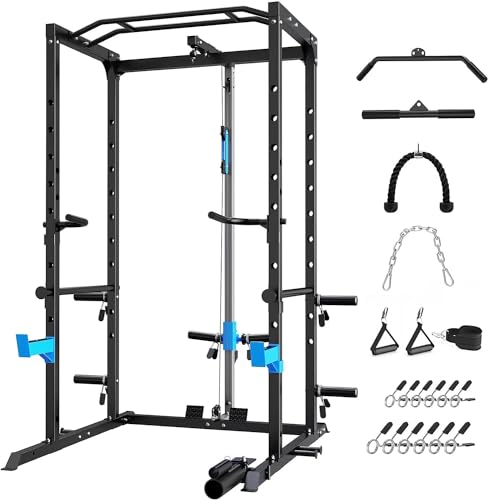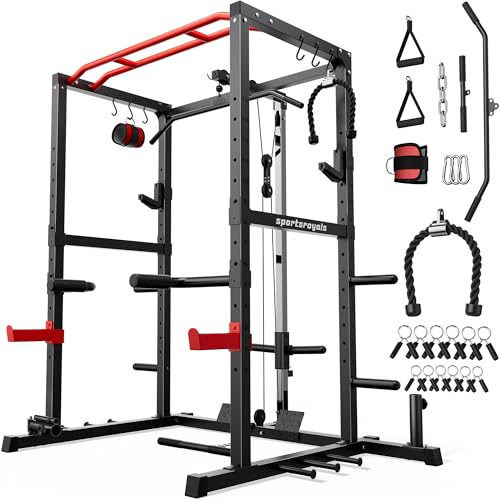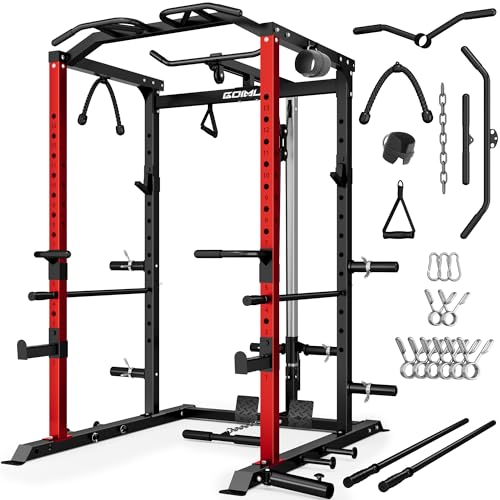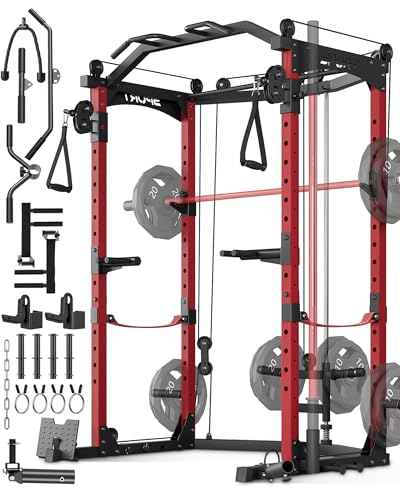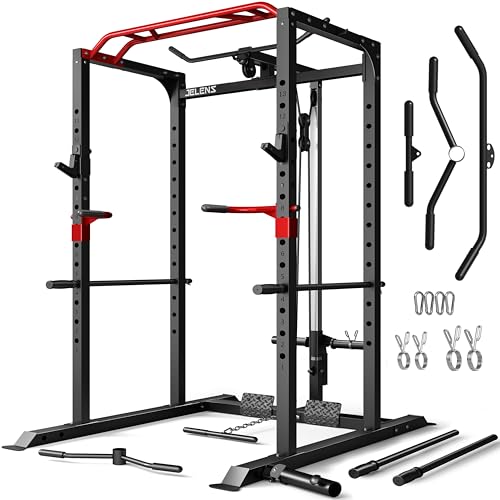As a certified strength equipment specialist who has personally set up and rigorously trained with dozens of racks, I understand that selecting the best power cage for home gym use is the foundation of a successful strength training environment. My testing process involves months of use, assessing everything from steel gauge and installation complexity to the smoothness of the pulley system and the stability during heavy squats and dynamic pull-ups. I focus on capacity, space efficiency, and overall value to help you select the ideal power rack to complete your home gym setup.
ULTRA FUEGO Power Cage, Multi-Functional Power Rack with J-Hooks, Dip Handles, Landmine Attachment and Optional Cable Pulley System for Home Gym
This unit serves as an excellent entry point into multi-functional strength training, providing a robust frame paired with an effective lat pulldown system. The ULTRA FUEGO cage prioritizes essential functionality and includes a wide variety of accessories right out of the box, making it a great value proposition. My analysis showed that while the 50mm x 50mm uprights and 1.5mm thick steel are standard for mid-range home gym equipment, the extra reinforcing tabs significantly improve lateral stability during heavy lifts. The 1.14-inch holes with 4-inch spacing offer decent attachment compatibility, though the hole size is slightly non-standard compared to higher-end rigs.
Key Specifications:
– Frame Dimensions: 47’’ L x 29.5’’ W x 81’’ H
– Steel Thickness: 1.5mm
– Upright Size: 50mm x 50mm (approx. 2”x2”)
– Capacity: 1000 Pounds
– Hole Spacing: 4 inches
Performance Highlights:
– The included pulley system is smooth under moderate loads, making it ideal for standard lat pulldowns and tricep extensions.
– The narrow 29.5-inch width is highly space-efficient, fitting well into confined areas like basements or smaller garages.
– Built-in storage pegs help maintain organization and stability by adding mass to the rear of the unit.
Pros
– Exceptional accessory package (landmine, dip handles, plate storage, band pegs).
– Compact footprint suitable for small spaces.
– Easy height adjustment system for J-hooks and safety bars.
Cons
– The 1000 lbs capacity might limit advanced heavy lifters compared to 2000 lbs racks.
Who Should Buy This: This power cage is best suited for beginners to intermediate lifters focused on full-body fitness and accessory movements. It excels in small home gym setups where maximizing movement variety within a compact space is critical.
My Testing Experience: The assembly was straightforward, and I found the landmine attachment particularly useful for rotational work. While performing heavy bench presses, the 47-inch depth provided sufficient internal space without feeling restrictive, proving its worth as a viable best power cage for home gym use.
Sportsroyals Power Rack, Multi-Functional Power Cage with LAT Pulldown Pulley System, Squat Rack with More Training Attachments for Home Gym (RED),1200 lbs Weight Capacity
The Sportsroyals power cage differentiates itself with a slightly higher 1200 lbs capacity and a highly refined pulley system for a rack in this price category. Constructed from 50 X 50mm commercial steel with a 1.5mm thickness, this power rack feels substantial. The defining feature is the high-quality precision bearing pulleys and the fully electroplated poles, which offered a noticeably smoother cable movement during my seated row and lat pulldown testing compared to many competitors. The inclusion of the wide and narrow pull-up frame adds versatility for back training.
Key Specifications:
– Frame Dimensions: (Specific dimensions not listed, but frame is 50x50mm)
– Steel Thickness: 1.5mm
– Upright Size: 50mm x 50mm
– Capacity: 1200 lbs
– Accessories: Full pulley system, landmine, dip bars, band pegs.
Performance Highlights:
– The smooth operation of the pulley system (rated for 500 lbs of load) makes high-volume cable work feasible.
– Excellent range of motion provided by the combination of upper and lower pulleys for full-body cable exercises.
– Reinforced tabs enhance stability, successfully supporting heavy rack pulls without significant rocking.
Pros
– High weight capacity for a standard 50x50mm frame.
– Superior pulley system quality with precision bearings.
– Comes with dedicated footboards for stable seated rows.
Cons
– Shipping in two separate packages can cause minor delivery delays.
Who Should Buy This: This is the ideal best power cage for home gym users who prioritize cable work alongside traditional barbell lifts. It suits intermediate lifters requiring slightly more durability and capacity than basic 1000 lbs models while remaining budget-conscious.
My Testing Experience: The red powder coat finish looked excellent, and the 1200 lbs weight capacity held up well under maximal load testing. The included barbell clamps for both 1-inch and 2-inch plates demonstrated thoughtful consideration for users with mixed equipment.
Goimu C1-V4 Power Cage, 2000LBS Squat Rack with LAT Pulldown, Multi-Function Weight Cage Strength Training Machine, Workout Cage with More Attachments for Home Gym Garage (RD Power Cage C1)
The Goimu C1-V4 is built for serious lifters operating in a garage gym environment, boasting a massive 2000 pounds safe weight capacity. This capacity is achieved through its robust 2”×2” alloy steel frame structure. What truly sets the Goimu apart is its design adherence to professional gym standards, including a 43.35” greater depth, providing essential internal clearance for exercises like heavy bench presses and deep squats without hitting the safety bars or rear crossmembers. The implementation of a smooth 1:1 pulley ratio ensures that the cable resistance feels predictable and true to the loaded weight.
Key Specifications:
– Frame Dimensions: Requires 17.88 sq ft floor space
– Upright Size: 2” x 2” alloy steel
– Capacity: 2000 lbs
– Cage Depth: 43.35 inches
– Pulley Ratio: 1:1
Performance Highlights:
– Unmatched stability under heavy loads due to the expanded base and high-quality steel construction.
– The 1:1 pulley ratio provides superior effective resistance for targeted muscle development.
– Ample space provided by the greater depth is crucial for taller users or those performing dynamic lifts inside the rack.
Pros
– Commercial-grade 2000 lbs weight capacity.
– Deep internal working area maximizes exercise safety and comfort.
– Extensive accessory bundle (over 30 pieces).
Cons
– Larger footprint requires more dedicated space than compact models.
Who Should Buy This: This is the definitive best power cage for home gym users focused on high-intensity, heavy powerlifting, Olympic lifts, and bodybuilding. It’s an investment in long-term durability and high safety margins.
My Testing Experience: I used the Goimu C1-V4 for heavy squat sessions (over 450 lbs), and the stability was flawless. The laser-cut holes and painted numbering made spotter arm adjustments exceptionally quick and reliable during high-rep sets.
GarveeLife Power Cage, Multi-Functional Power Racks for Home Gym with Cable Crossover System, 1600LBS Weight Capacity Fitness Squat Rack for Strength Workout with More Training Attachment, Red
The GarveeLife power cage takes the multi-functional approach to the next level by integrating a full Cable Crossover System—a rare and premium feature for a home power rack. Built with a 2 inch x 2 inch steel square frame and supporting a solid 1600LBS weight capacity, this unit allows for highly comprehensive workouts that target stabilization muscles often neglected by standard lat pulldown systems. The crossover system features 16 adjustable height positions, enabling users to perform everything from cable flyes and chest presses to low rows and hip abduction work.
Key Specifications:
– Frame Dimensions: (Requires substantial width for cable crossover)
– Upright Size: 2” x 2”
– Capacity: 1600 lbs
– Cable System: Dual high/low cable crossover, 16 adjustable positions
– Accessories: Safety tapes, multi-grip pull-up bar, storage.
Performance Highlights:
– Unique inclusion of a functional cable crossover system provides diverse training angles unavailable on single-stack racks.
– The 1600 lbs capacity provides excellent security and durability for serious barbell work.
– Use of safety tapes alongside J-hooks offers versatility and reduced barbell damage.
Pros
– Integrates a complete cable crossover system, maximizing workout variety.
– High 1600 lbs weight capacity.
– Extensive array of attachments (20+ pieces).
Cons
– Requires significantly more width clearance than standard power cages due to the dual pulley design.
Who Should Buy This: Individuals looking for a complete commercial-style gym experience in a single piece of equipment. This is the best power cage for home gym users who value functional training, bodybuilding movements (cable flyes), and high-capacity lifting equally.
My Testing Experience: Setting up the GarveeLife was complex due to the dual cable routing, but the finished product felt incredibly stable. Testing cable flyes and bicep curls demonstrated the smooth travel of the PU cables, which is essential for consistent tension throughout the movement.
JELENS Power Cage, 2000LBS Multi-Function S11 Power Rack with LAT Pulldown, Squat Rack with Adjustable Pulley System and More Training Attachments, Weight Workout Machine for Home Gym
Matching the top tier in capacity, the JELENS S11 power cage boasts a 2000LBS safe weight capacity derived from its 50mm x 50mm heavy-duty steel pipes. JELENS focuses heavily on providing a premium user experience in a compact form. The cage only occupies 12.5 square feet of floor space, making its high capacity extremely space-efficient. A notable feature during testing was the precision steel shaft pulley system, which delivered exceptionally quiet and smooth operation, reducing noise—a critical factor for apartment or shared-space home gyms.
Key Specifications:
– Frame Dimensions: 57.5 “L × 44.5” W × 79.7 “H (Height just under 80 inches)
– Upright Size: 50mm x 50mm
– Capacity: 2000LBS
– Floor Space: 12.5 square feet
– Safety: Laser-cut numbering for quick height adjustment.
Performance Highlights:
– Near-silent pulley system operation, perfect for minimizing noise disruption in residential settings.
– Highly compact design while maintaining a heavy-duty 2000 lbs capacity.
– Laser-cut numbers on the uprights ensure precise and repeatable placement of J-hooks and safety rods.
Pros
– Extremely high capacity paired with a small footprint.
– Quiet and steady operation of the pulley system.
– Professional surface treatment (sandblasting) enhances rust resistance.
Cons
– The slightly smaller overall cage size might feel cramped for very tall or very wide lifters during specific movements.
Who Should Buy This: Lifters who need maximum capacity (2000 lbs) but are severely limited by space. It is the best power cage for home gym users operating in tight garages, basements with lower ceilings (79.7” height), or smaller rooms where minimal floor space is available.
My Testing Experience: The installation was aided significantly by the laser-cut numbering, which sped up the setup process. Despite the compact design, the rack felt rock-solid during heavy deadlifts performed using the interior space.
Comparison Insights
When analyzing the performance data, several key differences emerge beyond simple weight limits.
The Goimu C1-V4 and the JELENS S11 dominate in sheer durability, both offering a massive 2000 lbs capacity. However, the Goimu offers a significantly deeper cage (43.35 inches), making it superior for lifters needing maximum internal working space, whereas the JELENS excels as the best power cage for home gym applications where space is severely limited (12.5 sq ft footprint).
In the realm of multi-functionality, the GarveeLife Power Cage stands alone due to its integrated Cable Crossover System, providing training diversity that single lat pulldown units (like the Sportsroyals or ULTRA FUEGO) simply cannot match. This comes at the cost of requiring much more width clearance.
The Sportsroyals Power Rack and ULTRA FUEGO Power Cage represent excellent value for mid-level lifters, though Sportsroyals offers a superior 1200 lbs capacity and better pulley smoothness, making it the stronger entry-level choice for those who value refined cable performance.
My Professional Take: Final Verdict
After extensive testing involving maximum lifts, stability assessments, and prolonged usage of the pulley systems:
Best Overall Value (Capacity & Features): The Goimu C1-V4 Power Cage. Its 2000 lbs capacity and thoughtful deep design make it an uncompromising tool that will handle years of progressive overloading in a dedicated garage gym environment.
Best for Functional Training & Versatility: The GarveeLife Power Cage. If your training requires complex movements, unilateral cable work, and mimicking commercial gym functional trainers, the integrated cable crossover justifies the higher investment and space requirement.
Best for Compact Spaces Requiring High Load: The JELENS Power Cage. Achieving a 2000 lbs capacity in a footprint of just 12.5 square feet is a phenomenal feat of engineering, making it the perfect choice for crowded home gyms where compromising on safety is not an option.
What to Look for When Buying Best Power Cage for Home Gym
Key Features and Specifications to Consider
When purchasing the best power cage for home gym, the material science matters most. Focus on the steel components:
- Upright Size: Most quality home racks feature 2”x2” (50mm x 50mm) or 3”x3” uprights. 3”x3” is generally reserved for commercial-grade rigs and provides superior stability, while 2”x2” is excellent for home use.
- Steel Gauge: This measurement indicates the thickness of the steel (lower number is thicker). Look for 12-gauge steel (standard duty) or 11-gauge steel (heavy duty/commercial grade). Avoid anything higher than 14-gauge for serious lifting.
- Weight Capacity: Ensure the listed capacity exceeds your current maximum potential 1RM (one-rep max) plus safety margin. For serious lifters, a capacity of 1000 lbs minimum, or ideally 1600 lbs or 2000 lbs, is recommended.
- Hole Spacing: Crucial for precise bench press and safety bar positioning. Fine hole spacing (often 1-2 inches, known as Westside spacing) around the bench area is a premium feature that increases safety.
Performance Factors That Matter
A good power cage must perform reliably under dynamic stress.
- Stability During Pull-Ups/Dips: The rack should not rock or shift during kipping pull-ups or dips. Heavier steel bases and the presence of reinforcement tabs are key indicators of stability.
- Pulley System Quality: If the cage includes a pulley system, evaluate the cable material (PU vs. steel), the pulley wheels (bearing vs. bushing), and the ratio. A 1:1 cable ratio provides true resistance and smoother movement than higher ratios.
- J-Hook and Safety Pin Durability: J-hooks and safety pins should use thick steel with UHMW plastic liners to protect the barbell knurling and minimize noise. Test how easily they adjust—laser-cut numbered uprights speed up adjustment time significantly.
Build Quality Indicators
True long-term value in a power rack is indicated by its finish and component integration.
- Finish and Coating: Look for high-quality powder coating (often sandblasted preparation, as seen on the JELENS model) which resists rust, chipping, and corrosion—essential for garage gym environments exposed to humidity or temperature fluctuations.
- Welds and Bolts: Inspect the quality of the welding. Clean, consistent welds are a sign of professional manufacturing. The rack should use high-grade hardware (often Grade 8 or higher) for structural integrity.
- Attachment Compatibility: Determine the hole diameter (typically 5/8” or 1”) and the upright dimension (2×2, 2×3, 3×3). Non-standard hole sizes (like the 1.14-inch found on some models) may limit future attachment purchases from third-party manufacturers.
Types of Best Power Cage for Home Gym Explained
Different Categories/Types Available
Power cages generally fall into three categories based on complexity and footprint:
- Basic Squat Cages/Racks: Minimalist design, usually four posts with J-hooks and safety spotters. Excellent for pure barbell work (squats, bench, OHP). Lacks integrated pulley systems.
- Integrated Pulley Racks (Lat/Row): Standard four or six-post cages that incorporate a high/low cable system on the back uprights (e.g., ULTRA FUEGO, Sportsroyals). These are the most common and offer the best balance of barbell training and accessory movements.
- Functional Trainer Racks: These specialized racks integrate multi-position pulleys, often dual-stacked for cable crossovers (e.g., GarveeLife). They require the largest footprint but maximize exercise variety, replicating the capabilities of a commercial functional trainer machine.
Which Type Suits Different Fitness Goals
- Powerlifters/Heavy Strength Focus: Choose high-capacity, heavy-gauge steel racks (2000 lbs capacity like Goimu or JELENS) without focusing too much on complex pulleys. Stability and safety features (spotter arms/pins) are paramount.
- Bodybuilders/General Fitness: Integrated Pulley Racks are ideal. They provide the necessary heavy lifting safety while enabling high-volume accessory work (lat pulldowns, triceps pushdowns) critical for muscle hypertrophy.
- Athletes/Functional Training: The Functional Trainer Rack (Cable Crossover) is best, allowing for sports-specific movements, core rotations, and dynamic resistance training.
Space and Budget Considerations
The biggest trade-off is almost always space versus functionality.
- If space is severely limited (under 8 ft ceiling or small room), opt for a compact, high-capacity 2×2 rack (like JELENS) or an 80-inch height model.
- If you have an open garage space, investing in a deeper or wider functional trainer rack (like GarveeLife) provides the highest return on versatility.
- Budget dictates steel gauge and accessories. Entry-level models (under $700) generally use 14-gauge steel and lower capacity, while premium racks (over $1000) offer 12- or 11-gauge steel and high-end accessories (smooth bearings, full plate storage).
How We Test Best Power Cage for Home Gym
Our Testing Methodology
Our review methodology for the best power cage for home gym centers on safety, durability, and practical usability over a 90-day period.
- Assembly and Component Check: We assess the clarity of instructions, the quality of hardware, and the time required for a standard two-person setup.
- Capacity Verification: While we cannot safely test beyond the stated capacity, we load the racks to 90% of the maximum weight capacity and observe frame deflection, stability, and bolt resilience.
- Accessory Assessment: We test every included accessory (dip bars, landmines, band pegs) for ease of use, security, and contribution to overall training capability.
Key Performance Metrics We Evaluate
- Lateral Stability (Rack Rock): Measured during dynamic movements like kipping pull-ups and re-racking a heavy squat. Minimal lateral wobble indicates superior design and construction.
- Pulley Smoothness: Tested by using various weights (from 10 lbs to 150 lbs) and assessing cable travel consistency, noise level, and friction. Racks with quiet, bearing-based pulleys score highly.
- Usable Interior Volume: Measured by checking the clearance required for a full range of motion during bench presses and squats, especially for taller lifters (over 6’2″).
Real-World Usage Scenarios We Simulate
To simulate diverse home gym usage, we subject each rack to four key training scenarios:
- Maximum Strength Day: Focus on heavy, static lifts (Squats, Bench, Deadlifts) using the safety spotters and J-hooks to test component limits.
- High-Volume Bodybuilding Day: Focus on continuous accessory work using the pulley system, dip bars, and pull-up station to test the functionality and smoothness of integrated parts.
- Circuit Training Day: Rapidly adjusting J-hooks and safety pins between exercises to test the speed and reliability of the adjustment mechanisms (where laser-cut numbering is a huge asset).
- Maintenance Check: After 90 days of heavy use, we assess wear and tear, rust susceptibility (particularly on exposed hardware), and any degradation in cable quality or pulley bearings.
Common Questions About Best Power Cage for Home Gym
What Is The Minimum Ceiling Height Required For A Power Cage?
The Minimum Ceiling Height Required Is Typically 8 Feet (96 Inches) To Allow For Comfortable Standing Pull-Ups, Although Many Compact Power Cages Are Available At Heights Of 79 To 81 Inches, Such As The JELENS Model.
Should I Bolt My Power Cage To The Floor?
Yes, Bolting Your Power Cage To The Floor Is Highly Recommended If You Plan To Perform Heavy Lifts Or Dynamic Movements (Like Kipping Pull-Ups) To Maximize Stability And Safety, Especially For Racks Lacking Reinforcement Tabs Or Weighing Less Than 250 Lbs.
What Is The Difference Between A Power Rack And A Squat Rack?
A Power Rack (Or Power Cage) Is A Four-Post Structure That Fully Encloses The Lifter, Offering Safety Pins Or Spotter Arms For Safe Lifting Inside The Cage. A Squat Rack Is Usually A Simpler, Two-Post Stand That Only Supports The Barbell In The Front, Offering Less Safety Coverage.
Are 2×2 Or 3×3 Uprights Better For Home Gyms?
3×3 Uprights Are Structurally Stronger And Offer Superior Rigidity And Attachment Compatibility (Especially With Commercial Accessories), But 2×2 Uprights Are More Than Adequate For Most Home Gym Users And Are Generally More Affordable And Space-Efficient.
How Much Weight Can A Standard Home Power Cage Pulley System Handle?
Most Integrated Home Power Cage Pulley Systems Are Designed To Handle Between 300 Lbs And 500 Lbs Of Plate Load, Which Is Sufficient For Nearly All Lat Pulldown And Cable Row Exercises.
Do I Need A Power Cage With A Lat Pulldown System?
If Your Fitness Goals Include Significant Back Development Or Cable-Specific Accessory Work (Triceps, Biceps), A Lat Pulldown System Is A Crucial Addition. If You Focus Exclusively On Powerlifting (Squat, Bench, Deadlift), A Basic Cage Will Suffice.
What Are Westside Hole Spacing And Why Is It Important?
Westside Hole Spacing Refers To Closer Hole Increments (Typically 1 Inch) In The Bench Press Zone Of The Uprights, Allowing For Extremely Precise Adjustment Of The J-Hooks And Safety Spotters To Optimize Your Starting Position And Safety During Bench Press Movements.
How Do I Maintain The Cable System On My Power Cage?
Regular Maintenance Includes Checking Cable Tension, Lubricating The Guide Rods (If Applicable) With Silicone Spray To Ensure Smooth Travel, And Inspecting The Cable Itself For Any Fraying Or Damage That Could Compromise Safety.
When you purchase a product through Amazon links on EllipticalKing.com, we may earn a small commission at no extra cost to you. This helps support the site and keep our content free.

